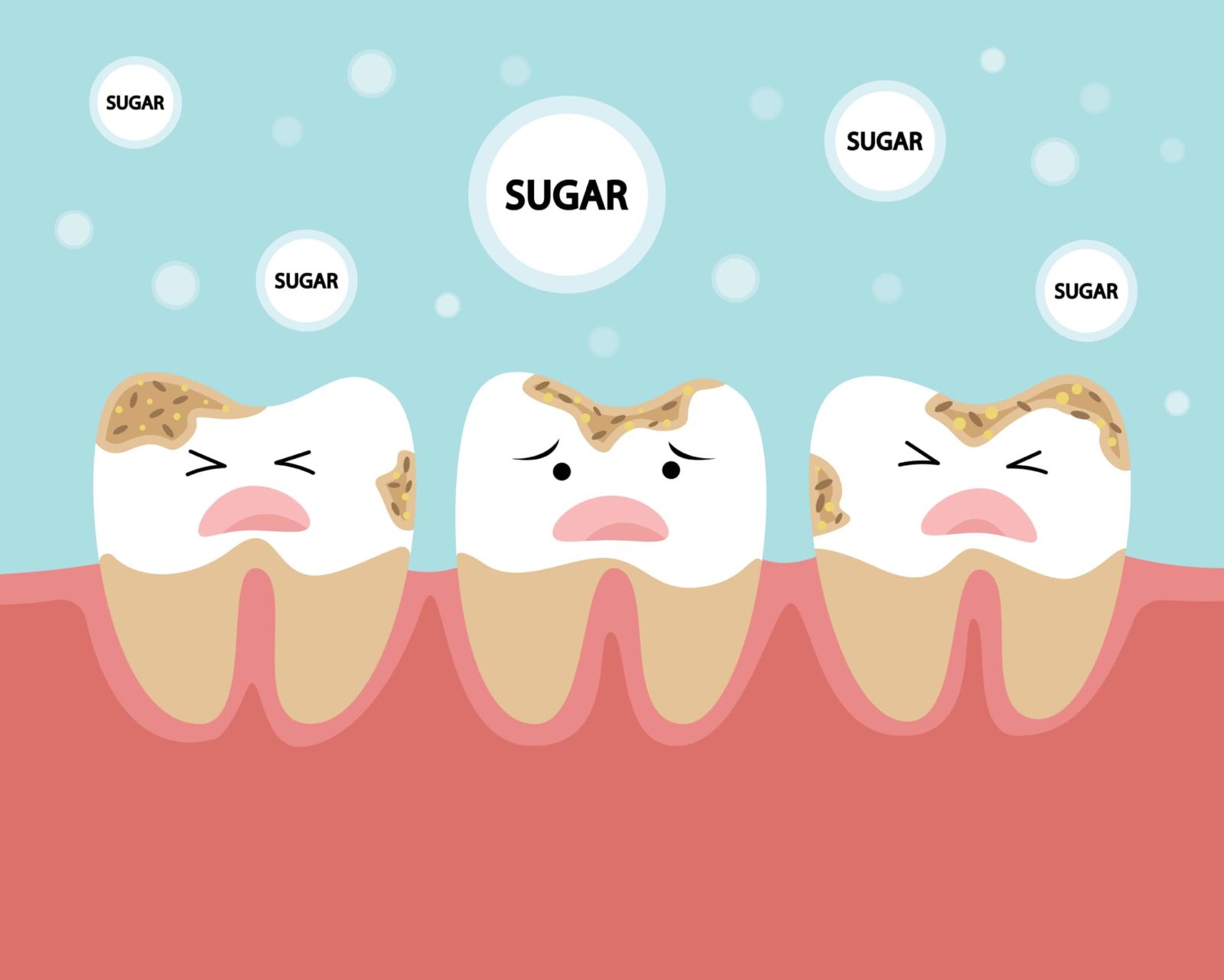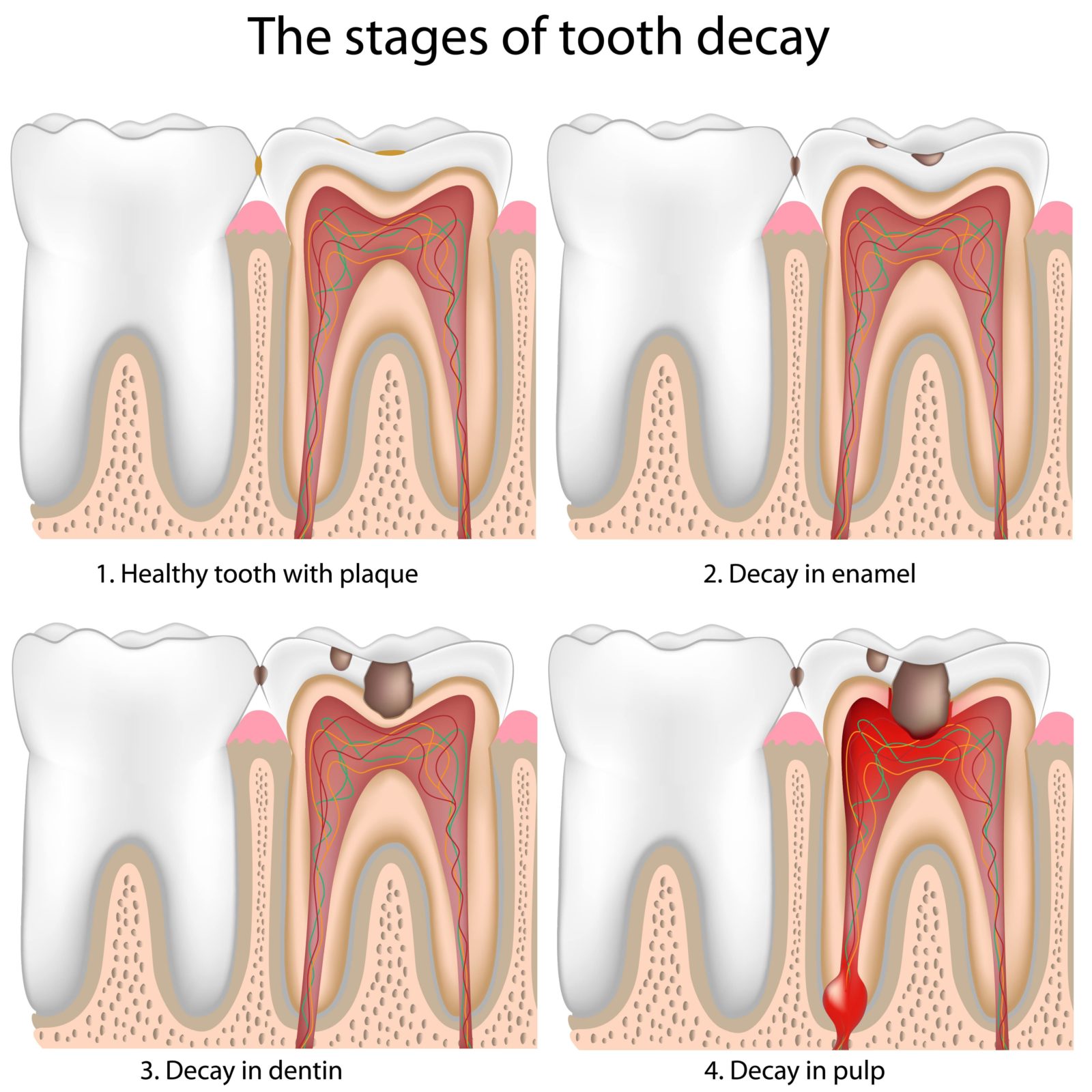Your children look to you when it comes to their oral health. They may even ask you oral health related questions that you may or may not know the answer to. Once such question is “how long does it take for a cavity to form”? This can be an especially pressing question during nightly brushing and flossing sessions when you try to explain the importance of dental hygiene to your child. While you can tell your child it takes a while for a cavity to form, it is important that you know the ins and outs of what cavities are, how they develop, and how long it takes.
What is a cavity?
A cavity is a hole that forms in the tooth. They are caused by bacteria that live in the clear, sticky film known as plaque. When food particles become trapped in plaque, bacteria feed on sugars and starches in these food particles, then they produce an acidic waste product. When this acidic waste product is regularly deposited in the same place on the tooth, it eventually erodes the enamel and causes a hole to form.
There are three types of cavities that are named based on the part of the tooth that they affect. These include:

- Pit and fissure cavities, which are found in the various pits and fissures on the chewing surface of molars and premolars. Because this location is highly texturized and towards the back of the mouth, it is a common location for cavities in children.
- Root cavities, which are found on the tooth roots in cases where the gums have receded. This is because the tooth roots have a very thin layer of enamel and are more susceptible to decay when they are not properly protected by the gums.
- Smooth-surface cavities, which affect the smooth parts of the teeth, such as the front and sides. In children, smooth-surface cavities are generally found on the two upper teeth and are known as baby bottle tooth decay.
How does a cavity form?
Cavities don’t just appear out of nowhere. Instead there is an entire process to cavity formation. Understanding this process is a key element in preventing cavities, as well as knowing when to schedule a dental appointment for the necessary treatment. There are five stages of cavity development, including:
Stage 1: Demineralization
Demineralization is the process of the enamel losing minerals. Since minerals are what gives enamel its strength, losing minerals causes the enamel to weaken. This is the first sign that the acids from bacteria are damaging the enamel and it is seen as white spots on the teeth. If you notice these spots, your child’s pediatric dentist may be able to remineralize the enamel with fluoride treatments.
Stage 2: Enamel Decay
After the enamel has been weakened by demineralization, the acids from bacteria will start to erode the enamel itself. This will cause a small to medium cavity to form. Once the cavity has formed in the enamel, the tooth will need to be restored with a composite filling.
Stage 3: Dentin Decay
After eroding through the enamel, the bacteria will reach the dentin layer just under the enamel. Once decay has reached the dentin layer, the cavity tends to grow in size and may need to be repaired using a stainless steel dental crown. Additionally, decay in the dentin layer may cause your child to experience tooth sensitivity.

Stage 4: Pulp Decay
Decay in the dentin layer tends to spread faster until it reaches the pulp layer. The pulp is the innermost layer of the tooth and it contains blood vessels and nerves. When bacteria reaches the pulp, it causes a painful infection known as pulpitis. Once the pulp has been infected, your child’s dentist may opt to perform a baby root canal or a traditional root canal in order to restore the tooth.
Stage 5: Abscess
If the decay spreads from the pulp chamber into the roots through the root canals, then this can cause an abscess to form at the base of the tooth roots. At this point, extraction is usually recommended to prevent the infection from spreading to the adjacent teeth.
How long does it take a cavity to form?
Now that we have a better understanding of what a cavity is and the various stages of its development, we can address just how long it can take to form. While all cavities are different, most cavities tend to progress over a period of years. However it is also fairly common for cavities to develop in a matter of months in children. This is because primary teeth have a thinner layer of enamel than permanent teeth, making it easier for cavities to develop at a faster rate.
The location of the cavity can also play a role in how fast or slow it develops. Just as certain locations are also more prone to cavities because they tend to accumulate more plaque and bacteria, cavities that form in these locations tend to develop faster because of the high bacteria population. Generally speaking, this is why pit and fissure cavities tend to grow faster than smooth-surface cavities.
Finally, your child’s dietary and oral health habits also play a role in how long it takes a cavity to develop. Not only do children who consume less sugar have less cavities, but their cavities grow at a much slower rate than children who regularly consume higher amounts of sugar. Additionally, children who regularly visit the dentist for cleanings and preventative treatments like dental sealants also have slower-growing cavities. Professional dental care is especially important for children since they don’t always know how to brush and floss properly to prevent cavities. Taking your child to their pediatric dentist twice a year for cleanings and other preventative treatments not only reduces the risk of developing cavities, but it also slows the growth of cavities and allows their dentist to catch decay before it progresses.






